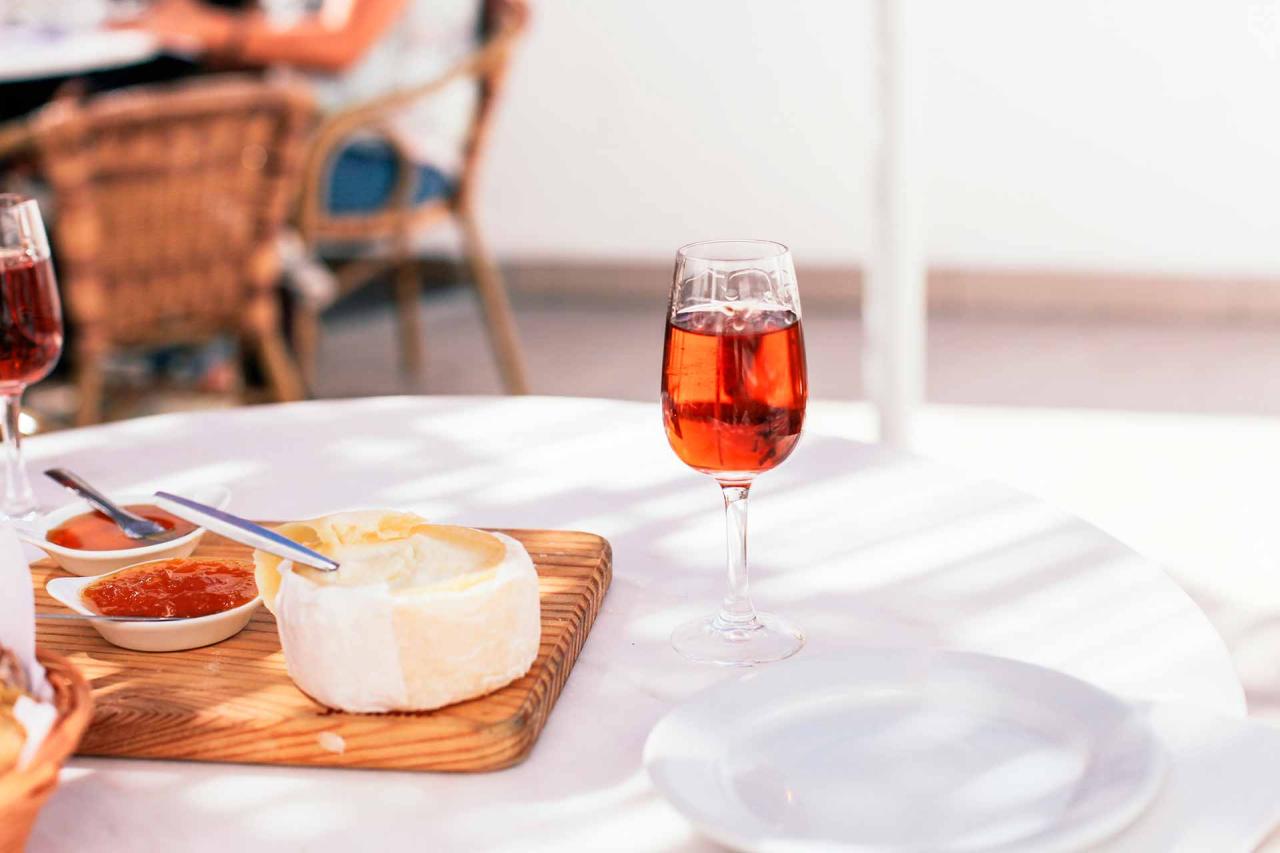Portugal, with its vast Atlantic Coast, arid flatlands and rugged hills, has the perfect conditions for ripening wine grapes to perfection — it’s no surprise there are so many Portuguese wine styles. Portuguese sweet wine is amongst the most popular worldwide, and yes, fortified Portuguese wine might be famous, but the style is more complex than one could ever imagine!
Let’s explore the sweet Portuguese wine scene and learn how to pair Portuguese dessert wine with traditional Portuguese desserts and other food.
Get updates on the latest posts and more from Wine Bugle straight to your inbox.

Port Wine
Port, also known as Porto or Oporto, is the most famous Portuguese sweet wine. It is a fashionable after-dinner drink, and the sweetest Port wine is amongst the most luscious and decadent in the category.
Port is exclusive to the northern region surrounding the Douro River, all the way down towards the Atlantic Ocean, through the town of Vila Nova de Gaia. Port production goes back to 1756, making it one of the oldest wine styles still produced today — the wine became rampant in England, so most Port companies were, in fact, founded by British entrepreneurs — most Port brands have English and not Portuguese names.
Grapes grow up on the steep terraces overlooking the Douro River. Touriga Nacional, Touriga Franca, Tinta Roriz, Aragonez, Tinta Barroca and Tinto Cão are the most common grapes, but there are others. Touriga Nacional is the region’s flagship grape, and it’s a symbol of Portuguese wine. Port is produced on-site and was traditionally shipped in small boats down the river to be aged in the port city a few miles west. When used to make dry red wines, Port producers must label their wines as Douro, not Port.
Most Portugal dessert wine is fortified, and Port is no exception. The grapes are picked, crushed and fermented. The producers then stop fermentation by adding a neutral grape spirit to the fermenting must, stopping yeast in its tracks, resulting in naturally sweet wine with noticeable alcoholic warmth.

Ruby Port
Although all Port is made similarly, what gives this acclaimed Portuguese sweet red wine its characteristic flavor and bouquet is the blending and aging process. Sweet red wine in Portugal can be youthful and fresh or spicy and well-aged and the most fruit-forward style is labeled as Ruby.
Ruby is a type of Port aged in a way that it is protected from oxidation, so the wine’s fruit scents are unaltered. This is an inexpensive style, but it is crowd-pleasing delicious. Ruby Port is a combination of several vintages. Ruby Reserve is a bit more memorable, but it’s still a blend of youthful wines. As you can imagine, Ruby Port has a bright, ruby color.
Dessert pairing: Ruby Port pairs best with red fruit desserts, including tarts and jams.
Wine to try: Quinta do Portal Porto Alegre Ruby Port
Tawny Port
Tawny Port, as its name suggests, has a brick-brown color. This specialty ages oxidatively in wood casks. Oxidation not only changes the wine’s color but also influences its bouquet, adding nutty scents to the already rich wine.
Tawny Port comes in several styles as well. It can be labeled as regular Tawny or have an age statement: 10, 20, 30 or 40 years. This doesn’t mean a 40 Year Tawny is forty years old, as most Tawnies are a combination of vintages. Still, generally, Tawny Port with an age statement taste as you would expect from a well-aged wine.
Dessert pairing: Pair Tawny Port with chocolate desserts, especially if made with milk chocolate. Caramel and coffee desserts are also compatible with Tawny, as well as nuts and dried fruit.
Wine to try: Porto Ferreira Tawny.
Vintage Port
Unlike regular Rubies and Tawnies, producers make Vintage Port with fruit from a single vintage; therefore, the wine is a better expression of the season. Vintage Port is technically a Ruby Port, but it is bottled unfiltered, so it ages in bottle, not in cask, making it concentrated and, therefore, age-worthy. Port producers make Vintage Port just three or four times every decade, so it is a collector’s item.
Tawnies have their own vintage-dated wine, and it’s labeled as Colheita (harvest). Colheita Port ages in cask, not in bottle, so it doesn’t shed the same amount of sediments as Vintage Port.
Dessert pairing: Rich dark chocolate desserts, dates and other dried fruit. Vintage Port is also compatible with blue cheese. Decant vintage Port to remove its sediments.
Wine to try: 2017 Taylor Fladgate Vintage Port
White and Rosé Port
Taylor’s introduced White Port in 1934, so the style is relatively recent compared to regular Ruby and Tawny Port. The sweet white wine has gained popularity in Portugal and abroad for its hints of peaches and flowers over a honeyed palate.
The most common grapes for this Portuguese sweet white wine are Codega, Malvasia Fina, Rabigato and Viosinho. White Port is delicious on its own and has found a way into bars, where it is sometimes mixed in cocktails.
Dessert pairing: Try White Port with custards, meringues, pastry cream and honey-based desserts, such as baklava.
Wine to Try: Kopke Colheita White Port
Rosé Port is even younger than White Port. It debuted in 2008 when Croft released a pink version of the traditional Ruby wine — others soon followed. The same grapes used to make regular Port are behind this light-colored wine, but the grapes are not allowed to macerate with the skins for long, therefore, the wine is pale rather than inky.
Dessert pairing: Cherry and red berry desserts, macarons, meringues, fruit tarts and other fruit-based desserts.
Wine to try: Croft Pink Rose Port
Madeira
Madeira is a sweet wine from Portugal produced on the volcanic island of Madeira in the Atlantic Ocean. This was a typical mid-point stop for ships going from Europe to America, which is why Portuguese producers started making wine on the island in the first place – the wine trade was significant for Portugal during the colonial era.
Traders discovered that the wine gained exciting flavors and aroma during the long sea voyage, as the wine effectively oxidized and “cooked” during the warm trip. It wasn’t long before winemakers inland started replicating the ship’s effects in wine.
Madeira is purposely oxidated in wood casks and cooked in heated tanks or estufagem or in warm cellars, canteiros. Wine can spend decades in these sun-exposed cellars, gaining complexity over time. The wines are naturally sweet and fortified, but there are several Madeira styles, and they’re not equally sweet. Although all Madeira wines have residual sugar, some can taste quite dry! They’re labeled as seco (dry.)
Producers make most Madeira with Tina Negra Mole, but the finest examples are made with Verdelho, Sercial, Bual and Malvasia. Every grape produces a different wine, making Madeira more than a wine style — it’s an entire category.
Food pairing: Dry Madeira, often hose made with Verdelho and Sercial, is an ideal pairing for seafood. Sweeter styles, made with Bual and Malvasia and typical Madeira with no varietal on the label, are best enjoyed with nutty desserts, honey, puff pastry, custards and cheesecake.
Wine to try: D’Oliveiras Bual Vintage Madeira, Portugal

Moscatel de Setúbal
Setúbal is a peninsula south of Lisbon. Although the region’s wines are not as famous as Port and Madeira, Moscatel de Setúbal is a must-try, especially if you like sweet wine from Portugal.
Moscatel de Setúbal might not be the most popular Portuguese wine, but it is undoubtedly delicious. The main grape in the area is Muscat of Alexandria. Winemakers often macerate their sweet, fortified wine with the fragrant Moscatel grape skins to add extra layers of floral aromatics. Besides, the wine spends at least five years in oak, so it’s spicy and complex on the nose and palate.
Dessert pairing: This Portuguese sweet wine is best enjoyed with desserts with citrus scents, like lemon pies. Tropical fruit, such as mango and pineapple, are also compatible with Moscatel’s sweet scents.
Wine to try: Jose Maria da Fonseca Moscatel de Setubal
Carcavelos
Carcavelos is a small wine region south of Lisbon, just a few miles from the Atlantic Coast. Although the area traditionally focuses on dry red wines made with Ramisco grapes, producers are now experimenting with fortified wines.
Sweet Carcavelos has yet to prove its quality and consistency since the category is young and the producers few. Of course, the region has the perfect climate to ripen grapes, so there’s extraordinary potential for dry and sweet wines.
Dessert pairing: Red berries, milk and dark chocolate and nuts.
Wine to try: Villa Oeiras Vinho Generoso, Carcavelos
Fall In Love with Portuguese Sweet Wine
Portuguese sweet wine is among the sweetest and most complex — it’s also varied! There’s no doubt dessert wine is a specialty in the Iberian county. Port might be known worldwide, but now you know the robust wine style is not alone. Every Portuguese sweet wine is special and has an exciting story to share.
Enjoy the best brands from Portugal and experience sweet wine at its finest. In Portugal, sweet wine is a serious business, but that doesn’t mean the wine isn’t easy to enjoy. If you like sweet wine, try the best dessert wine Portugal has to offer!

